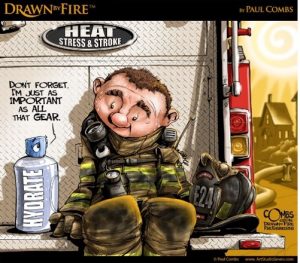 Normal hydration should be 64 to 88 ounces per day. A general rule is to drink one glass of water before meals and physical training and after calls that require donning bunker gear. However, on extended emergency operations with high metabolic demands, it is recommended to drink one liter or water per hour to replace fluids. Water replacement should be followed by drinks containing electrolytes. Avoid caffeine and energy drinks during emergency operations as they have a diuretic effect which can increase dehydration.
Normal hydration should be 64 to 88 ounces per day. A general rule is to drink one glass of water before meals and physical training and after calls that require donning bunker gear. However, on extended emergency operations with high metabolic demands, it is recommended to drink one liter or water per hour to replace fluids. Water replacement should be followed by drinks containing electrolytes. Avoid caffeine and energy drinks during emergency operations as they have a diuretic effect which can increase dehydration.
Manage the scene.
As conditions allow, move patients, suspects or bystanders you are interacting with into the shade, or air-conditioned vehicles or buildings. For EMS providers, move patients off the street or out of their hot home and into the air-conditioned ambulance sooner than you might otherwise.
When safe to do so, remove PPE layers, such as masks, helmets or hats, turnout gear and body armor, to improve heat loss through radiation, conduction, evaporation and convection. When the ambient air temperature is in the high 90s or 100s, passive heat loss is ineffective, so enhance cooling with misting fans, ice packs, cooling towels or immersion.
Your partner is also at risk when the temperatures climb. Early signs of dehydration, heat exhaustion and heat stroke include lethargy, confusion and other personality changes. If your partner seems “off,” take a water break out of the sun and humidity, and consider further assessment of their pulse rate, respiratory rate, mental status and recent water consumption.
Exercise is not without its risks and this or any other exercise program many result in injury. As with any exercise program, if at any point during your workout you begin to feel faint, dizzy or have physical discomfort, you should stop immediately and consult a medical professional. You should rely on your own review, inquiry and assessment as to the accuracy of any information made available within this program or via this web site.